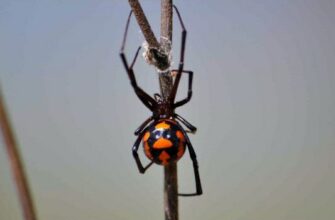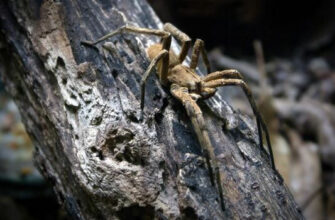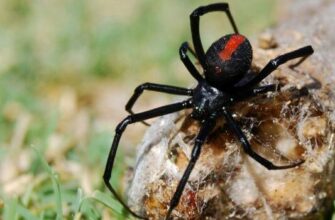The wolf spider is a sprinter in the world of arachnids. It does not spin webs, instead stalking and attacking its prey like a wolf. If you have seen this spider near your home, the encounter was probably unforgettable. Some people find them beautiful and unique, while others tremble at the sight of them.
Wolf spiders can be mistaken for tarantulas due to their thick and hairy bodies. Although they look menacing, they are useful and harmless organisms. Their diet consists of many pests that can enter people’s homes.
Origin of the species and description
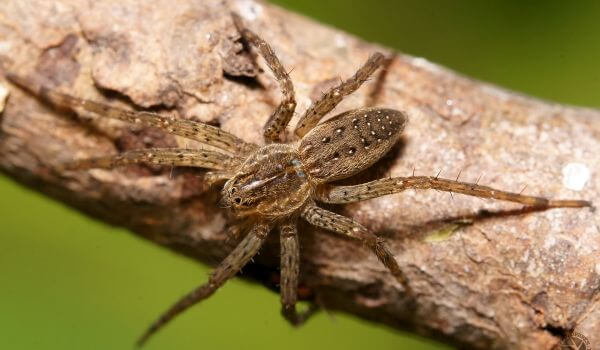
Photo: Wolf spider
Wolf spiders or ground spiders or hunting spiders are members of the Lycosidae family, the name comes from the ancient Greek word “λύκος” meaning “wolf”. This is a large and widespread group.
The wolf spiders got their name in honor of the wolf’s habit of pouncing on prey with the whole pack. Initially, it was believed that these insects also attack in a flock. Now this theory is recognized as erroneous.
There are over two thousand species belonging to 116 genera. About 125 genera occur in North America, about 50 in Europe. Numerous varieties are found even north of the Arctic Circle.
The evolution of spiders has been going on for 380 million years. The first spiders evolved from crustacean ancestors. More than 45,000 extant species have now been described. Fossil diversity rates represent a larger proportion than would be expected from the existing arachnid diversity at the moment. The main stages of evolution include the development of spinnerets and the separation of the web.
Video: Wolf Spider
Among ancient terrestrial arthropods — trigonotarbites, representatives of an extinct order of arachnids, are distinguished. they have many characteristics identical to spiders, including a terrestrial lifestyle, breathing, and eight-legged walking with a pair of foot pedals near the mouth. However, it is unknown if they had the ability to create webs. Trigonotharbids are not true spiders. Most of their species have no living descendants.
Appearance and Features
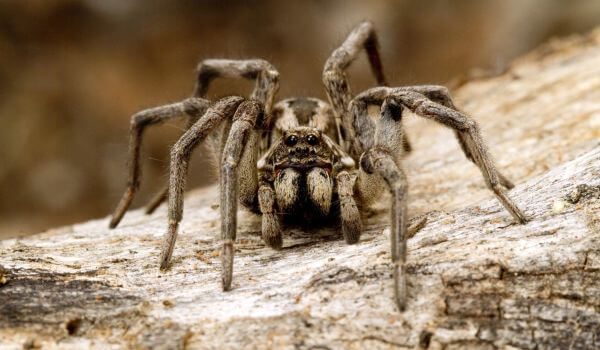
Photo: Wolf spider animal
Most wolf spiders are small to medium in size. The largest individual has a length of about 2.5 cm and legs of about the same length. They have eight eyes arranged in three rows. The bottom row has four tiny eyes, the middle one has two huge eyes, and the top row has two medium-sized eyes. Unlike other arachnids, they have excellent eyesight. The sensual hair on their legs and body gives them a keen sense of touch.
Flashing a beam of light towards the wolf spider produces an amazing radiance caused by the reflection of light from the eyes back to its source, thus creating a “glow” that is easy to spot.
Since spiders depend on camouflage to protect themselves from predators, their coloring does not have the bright, outrageous tones of some other spider species. Exterior colors correspond to a particular species’ favorite habitat. Most wolf spiders are dark brown. The hairy body is long and wide, with strong long legs. They are famous for their speed of movement. They are easy to identify by the number and location of the eyes. The jaws are protruding forward and strong.
The wolf spiders have a primitive structure:
- the cephalothorax performs the function of vision, food absorption, respiration and is responsible for the motor system;
- the abdominal cavity houses the internal organs.
Life expectancy depends on the size of the representatives of the species. Small varieties live for six months, larger species – 2 years, sometimes longer. Winter is experienced by fertilized females or born spiders.
Hogna — this is the largest genus of wolf spiders, with over 200 species that are found on all continents. Many smaller genera of wolf spiders live in grasslands and fields and feed on smaller prey, playing an important role in natural population control that keeps insect numbers in close proximity to wolf spiders.
Where does the wolf spider live?
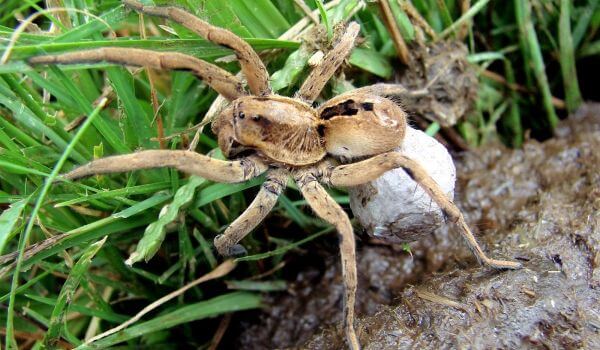
Photo: Poison Wolf Spider
Wolf spiders are able to live anywhere except Antarctica. Some species are found on cold, rocky mountaintops, others live in volcanic lava tunnels. They can be found in deserts, rainforests, grasslands and suburban lawns. One species has even been found in wheat crops feeding on pests such as aphids.
Some species of wolf spiders live in underground burrows, while most are found in the green natural landscape. They can often be found hidden in areas of the yard that provide shelter and protection for spiders, including:
- in leaves and around plants or shrubs;
- in tall or dense grass;
- under long-lying heaps and stacks of wood.
Unlike their four-legged namesakes, wolf spiders do not hunt in packs. They are lone “wolves” who do not want to meet people. Spiders of the genus Pirata are often found near ponds or streams, they have a V-shaped pale mark on the back. On the smooth surface of the water, they run without diving and hunt insects on the surface of the water. Burrowing wolf spiders (Geolycosa) spend most of their lives in burrows and have heavy front legs that are used for digging.
If any of them ended up inside a house, they most likely came to avoid extreme temperatures outdoors or because it is chasing another insect indoors. Wolf spiders try to move unnoticed through rooms at floor level. They do this by crawling along walls or under furniture.
What does the wolf spider eat?
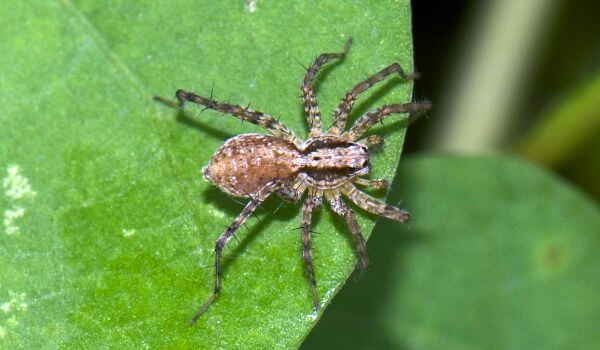
Photo: Male Wolf Spider
Wolf spiders don’t spin webs to catch their prey, they — real hunters and detect potential food visually or by vibration with their sensitive hairs. They often ambush and attack their prey surreptitiously or arrange a real chase after it.
Their menu can vary between insects such as:
- crickets;
- grasshoppers;
- beetles;
- ants;
- other spiders;
- aphids;
- flies;
- cicadas;
- moths;
- caterpillars;
- cockroaches;
- mosquitoes.
Some hunter spiders pounce on prey when they find it, or even chase it for short distances. Others wait for the prey to pass by or sit down near the hole. Once the wolf spiders catch their prey, they either grind it into a ball or inject venom into it, turning the poor guy’s internal organs into a smoothie. They eat their victims, pressing them to the ground or other surface with their paws. The spider can immobilize large victims by injecting a poisonous substance.
The limbs of spiders have 48 knee bends, that is, each paw has 6 joints. The wolf spider will inject venom if it is constantly provoked. Symptoms of its bite include swelling, mild pain, and itching.
In the past, necrotic bites were often attributed to some South American wolf spider species, however studies have shown that the problems that did occur were caused by bites from other genera. Australian members of the species have also been linked to necrotic wounds, but a careful examination of the bites also showed a negative result.
Character and lifestyle features
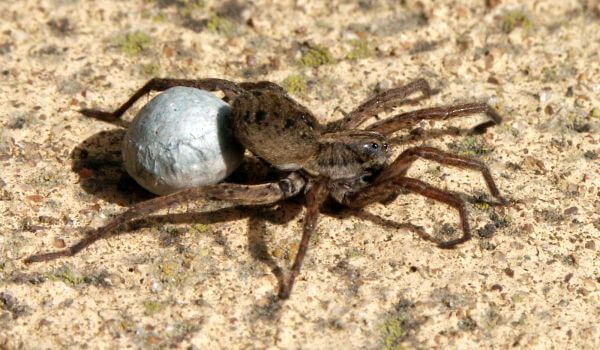
Photo: Female Wolf Spider
Wolf spiders live alone. Most of the species spend time on the ground. The dark, speckled colors of their bodies help blend in with decaying vegetation when they hunt or hide from predators. They sometimes burrow or make holes under rocks and logs to live in.
Some members of the Lycosidae, such as H. carolinensis, make deep burrows in which they hide most of the time. Others, such as H. helluo, seek shelter under rocks and other cover that nature provides. When they roam from place to place, they may end up in people’s homes when the weather turns cold. Males of almost any species can sometimes be found inside buildings when they roam in search of females in autumn.
Instead of blood, spiders have hemolymph, which contains copper in its composition. Once in the open air, it becomes blue. Veins + arteries are completely absent, the connection between organs is carried out with the help of hemolymph.
Most species build tubular nests in the ground with cobweb bedding. Some obscure the entrance with debris, others build a tower-like structure over the entrance. At night, they leave their secret hiding place and go hunting. The spider tries to find a convenient place so that the insect can pass by. From a distance of a few centimeters, the wolf spider leaps forward and grabs its prey.
Social Structure and Reproduction
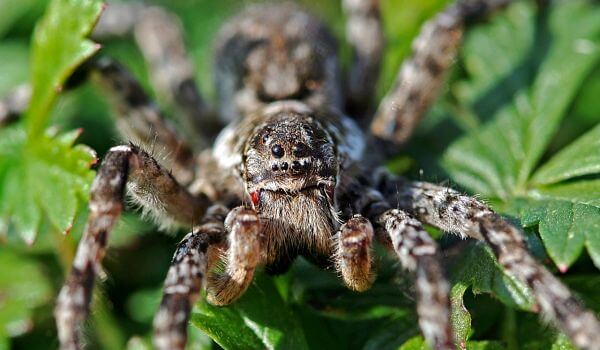
Photo: Wolf Spider
When it’s time to mate, males attract females by rhythmically flapping their long mouthparts (palps) or drumming them on leaves. The male approaches the female for mating with the front pair of legs raised. Readiness for mating is probably demonstrated by the smell, which is already audible at a distance of one meter.
Males of the species Allocosa brasiliensis may eat a female with poor reproductive ability or an old female incapable of reproduction. This biological fact was recorded for the first time.
The male then makes circular movements in accordance with the fixed pattern of pedipalps, in which the seed pockets are located. The mating female responds by tapping her front legs and taking a few steps towards the male, who then resumes courtship. This continues until they almost touch. In nocturnal species, acoustic signals play a large role, in daytime — optical.
The male crawls out onto the front of the female and bends down on one side of the abdomen to insert the first palpus. The woman flattens her belly. Then the second palpus is introduced from the other side. Wolf spiders are unique in that they carry their eggs with them in a cocoon. After mating, the female spins a round egg sack of cobwebs, attaches it to spinnerets at the end of the abdomen, and drags the unborn cubs with her.
This species of spiders has an extremely strong maternal instinct. If the female somehow lost her cocoon with the cubs, she becomes very restless, begins to wander aimlessly, trying to find it. If she fails to find the pouch, the female catches any object resembling it. These can be tiny pieces of cotton wool, cotton fibers, etc. In this way, she tries to create the illusion of bearing children.
The abdomen should be in a raised position so that the pouch does not drag on the ground. But even in this position, females are able to hunt. Another aspect characteristic of wolf spiders is their method of caring for young broods. Immediately after the spiders have emerged from the soft protective cover, they climb up the mother’s legs onto her back.
Hundreds of small wolf spiders cling to the mother’s hairs and sit on it in several layers, feeding on the epidermis. At this time, the mother wanders around to find the best microclimatic conditions and good shelter for her children. In order not to be in danger, she refuses to hunt for about eight days. The mother carries the spiders around for several weeks before they get big enough to fend for themselves.
Wolf spider’s natural enemies
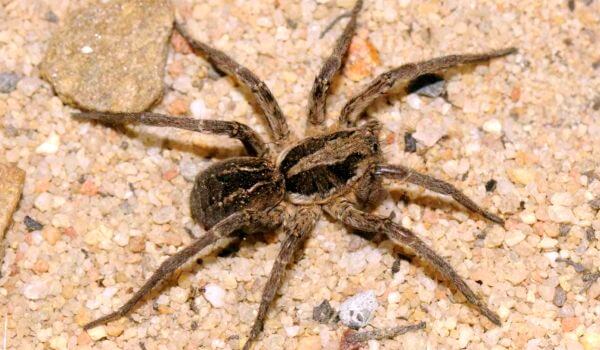
Photo: Animal spider wolf
There are many predators that would love to feast on the wolf spider, but these arachnids have several defense mechanisms to keep them from falling prey to the food chain. Wandering spider wolf species use their agility and speed, as well as their unique coloring to blend in with their surroundings.
Predators to watch out for include:
- wasps. They do not eat the spider, but temporarily paralyze it with a sting before inserting the egg inside. As the larvae mature, these nascent organisms eat the spider from the inside. Some wasps drag the spider to their nest and completely overwhelm it, protecting the larvae. Other varieties place an egg inside and then let the wolf spider run freely;
- amphibians and small reptiles. Amphibians also enjoy delicious food provided by the wolf spider. Creatures such as frogs and salamanders are known to feed on various types of spiders. Predatory amphibians will usually eat any creature small enough for them to swallow whole. Small reptiles such as snakes and lizards also eat wolf spiders, although larger species may skip this spider in favor of a larger meal;
- shrews and coyotes. Although wolf spiders are arachnids, they are close enough to insects that they are often preyed upon by shrews. These tiny creatures need constant food intake to keep their energy levels up. Coyotes also occasionally eat wolf spiders;
- birds. While some birds prefer seeds and vegetation, other birds tend to enjoy live prey. Numerous bird species, including owls and hummingbirds — elves are predators of the wolf spider. These arachnids do not use webs, so they must go out to hunt and forage, making them vulnerable to attack from above.
If the wolf spider is forced to fight, it will bite its opponents with its large jaws. If he faces death, he is willing to sacrifice even a leg to survive the situation, although losing a leg makes them slower and more vulnerable to future attacks.
Population and species status
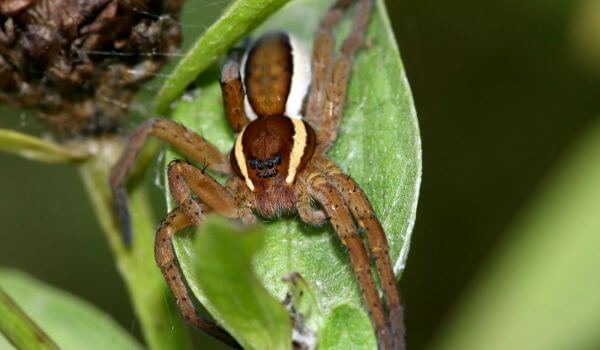
Photo: Poisonous Wolf Spider
Almost all wolf spider species have stable populations. They live in large numbers around the world. However, some, such as the desert wolf spider from Portugal and the cave spider Adelocosa anops from the island of Kauai in the Hawaiian archipelago, are endangered. The resemblance of the wolf spider to the dangerous predator karakurt spider led to the fact that people began to destroy this species as soon as they see it inside their home and even when it is near their house.
This arachnid must be approached with caution, as it may turn out to be a spider and hundreds of spiderlings can escape from a crushed mother around the house.
The bite of a wolf spider can be painful, but it is absolutely not dangerous for healthy adults. This is because the venom has a low neurotoxic effect, so it does not cause much harm. However, sensitive people such as children, the elderly, and people with compromised immune systems may have some form of adverse reaction. Therefore, if children or the elderly live in the house, several steps can be taken to prevent infestation by wolf spiders:
- clear the vegetation around the perimeter of the house;
- remove debris in the yard, such as fallen trees, rocks, and piles of lumber;
- close any cracks or openings in the base of the house and around windows and doors;
- minimize outdoor lighting, as light attracts insects that spiders like to eat;
- if a wolf spider has made its way into the house, use sealant to destroy it.
Despite its menacing appearance, the wolf spider does not pose much of a threat for people. Although they are fast and aggressive when preying on their prey, they do not bite humans unless provoked. If you come across a wolf spider, its first impulse will be to retreat. However, if pursued or attempted to trap it, the spider will feel threatened and be much more likely to be hit back defensively.

